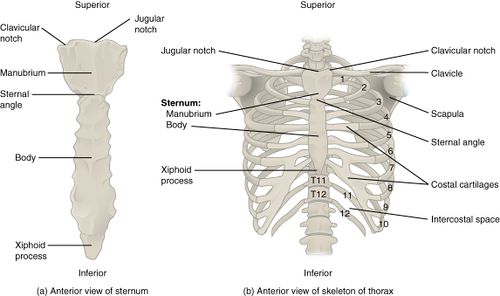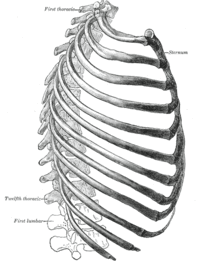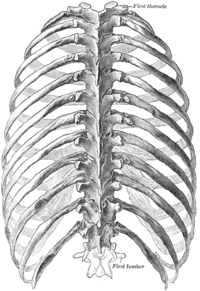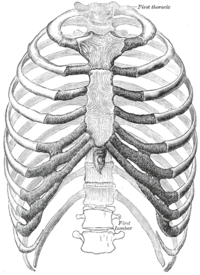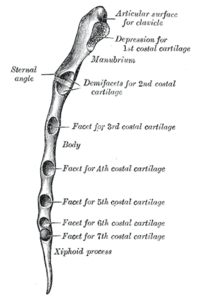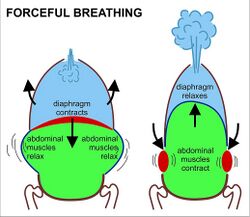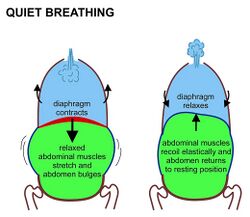Biomechanics of the Thorax: Difference between revisions
Sonal Joshi (talk | contribs) m (added new references) |
Sonal Joshi (talk | contribs) No edit summary |
||
| (13 intermediate revisions by the same user not shown) | |||
| Line 1: | Line 1: | ||
<div class="editorbox"> | <div class="editorbox"> | ||
'''Original Editor '''- [[User: | '''Original Editor '''- [[User: Sonal Joshi |Sonal Joshi]] | ||
'''Top Contributors''' - {{Special:Contributors/{{FULLPAGENAME}}}} | '''Top Contributors''' - {{Special:Contributors/{{FULLPAGENAME}}}} | ||
</div> | </div> | ||
== Introduction == | == Introduction == | ||
[https://www.physio-pedia.com/Biomechanics?utm_source=physiopedia&utm_medium=search&utm_campaign=ongoing_internal Biomechanics] is an area of science that uses principles of physics to measure and study, how forces interact with and affect living body<ref>Neumann DA. Kinesiology of the musculoskeletal system-e-book: foundations for rehabilitation. Elsevier Health Sciences; 2016 Nov 3.</ref>. These forces could be [https://www.physio-pedia.com/index.php?title=Introduction_to_Human_Biomechanics_-_Internal_Forces&redirect=no%3Futm_source%3Dphysiopedia&utm_medium=search&utm_campaign=ongoing_internal Internal] i.e. within the body or [https://www.physio-pedia.com/index.php?title=Introduction_to_Human_Biomechanics_-_External_Forces&redirect=no%3Futm_source%3Dphysiopedia&utm_medium=search&utm_campaign=ongoing_internal External] i.e. outside the body. | [https://www.physio-pedia.com/Biomechanics?utm_source=physiopedia&utm_medium=search&utm_campaign=ongoing_internal Biomechanics] is an area of science that uses principles of physics to measure and study, how forces interact with and affect living body<ref name=":0">Neumann DA. Kinesiology of the musculoskeletal system-e-book: foundations for rehabilitation. Elsevier Health Sciences; 2016 Nov 3.</ref>. These forces could be [https://www.physio-pedia.com/index.php?title=Introduction_to_Human_Biomechanics_-_Internal_Forces&redirect=no%3Futm_source%3Dphysiopedia&utm_medium=search&utm_campaign=ongoing_internal Internal] i.e. within the body or [https://www.physio-pedia.com/index.php?title=Introduction_to_Human_Biomechanics_-_External_Forces&redirect=no%3Futm_source%3Dphysiopedia&utm_medium=search&utm_campaign=ongoing_internal External] i.e. outside the body. | ||
To understand the biomechanics of thorax we will need to study the basic anatomy, joint articulations, muscles associated in the thorax along with kinematics of the rib cage. | To understand the biomechanics of thorax we will need to study the basic anatomy, joint articulations, muscles associated in the thorax along with kinematics of the rib cage. | ||
The thorax is formed by the thoracic vertebrae ,the ribs and the sternum. | The thorax is formed by the thoracic vertebrae ,the ribs and the sternum. | ||
[[File:Rib Cage.jpg|center|thumb|500x500px|Parts of Thorax]] | |||
It has two main functions, | |||
* Providing anchor for muscle attachments | |||
* Major role of ventilation | |||
== Structure of Thorax == | |||
The main three structures mentioned above work in a coordinated motion in thorax to produce [https://www.physio-pedia.com/How_We_Breathe#sts=Internal%20and%20External%20Respiration[edit%20|%20edit%20source]?utm_source=physiopedia&utm_medium=search&utm_campaign=ongoing_internal respiration]. | |||
==== Anatomy ==== | |||
* The rib cage is a system of various bones and muscle. Bones involved are sternum, 12 pairs of Ribs, 12 Thoracic vertebrae. | |||
It is like a compartment sealed by various structures from each side. | |||
* Refer to the diagram of anterior, posterior and lateral view of thorax to better understand the bones involved in the ribcage. | |||
= | * [[File:Thorax- Lateral view.gif|left|thumb|261x261px|Thorax -Lateral View]]They can be described as<ref name=":0" />, | ||
= | {| class="wikitable" | ||
|+[[File:Thorax- Posterior View.gif|left|thumb|291x291px|Thorax - Posterior View]][[File:Thorax-Anterior View.png|center|thumb|275x275px|Thorax -Anterior View]] | |||
!Side of compartment | |||
!Contents | |||
|- | |||
|Posterior-laterally | |||
|<nowiki>- Thoracic vertebrae</nowiki> | |||
- Ribs | |||
- Intercoastal muscles and membrane | |||
|- | |||
|Anteriorly | |||
| - Coastal cartilages | |||
- Sternum | |||
-Intercoastal muscles and membrane | |||
|- | |||
|Superiorly | |||
| - Upper ribs and clavicle | |||
- Cervical fascia surrounding esophagus and trachea | |||
|- | |||
|Inferiorly | |||
| -Diaphragm muscle | |||
|} | |||
Refer the [[Thoracic Anatomy]] for further details of Thoracic vertebrae & the joint which they form. | * The sternum consists of manubrium, body and xiphoid process. Its details can be referred to on page : [https://www.physio-pedia.com/Sternum?utm_source=physiopedia&utm_medium=search&utm_campaign=ongoing_internal sternum]. | ||
* The [https://www.physio-pedia.com/Ribs?utm_source=physiopedia&utm_medium=search&utm_campaign=ongoing_internal ribs] are from T1 to T12 region | |||
* Refer the [[Thoracic Anatomy]] for further details of [https://www.physio-pedia.com/Thoracic_Vertebrae Thoracic vertebrae] & the joint which they form. | |||
==== Articulations<ref name=":1">Pamela K. Levangie, Cynthia C. Norkin, 2005, Joint structure and function: A comprehensive analysis, 4th. Edn, Philadelphia, FA Davis publishers.</ref> ==== | |||
{| class="wikitable" | {| class="wikitable" | ||
|+ | |+[[File:Sternum-articulations.png|left|thumb|297x297px|Sternum -Articulations]] | ||
! | |||
!Joint | !Joint | ||
!Bones involved in the joint articulation | !Bones involved in the joint articulation | ||
!Special features | !Special features | ||
|- | |- | ||
|Manubriosternal | |1. | ||
|Manubrium and superior part of body of Sternum | |Manubriosternal | ||
| - Synchondrosis type of joint | |Manubrium and superior part of body of Sternum | ||
| - Synchondrosis type of joint | |||
- Also called Angle of Louis | - Also called Angle of Louis | ||
|- | |- | ||
|2. | |||
|Xiphisternal | |Xiphisternal | ||
|Xiphoid process and inferior part of body of Sternum | |Xiphoid process and inferior part of body of Sternum | ||
| - Synchondrosis type of joint | | - Synchondrosis type of joint | ||
- Ossifies by 40 to 50 yrs. of age | - Ossifies by 40 to 50 yrs. of age | ||
|- | |- | ||
|Typical Costovertebral | |3. | ||
| | |Typical [https://www.physio-pedia.com/Costovertebral_Joints Costovertebral] (CV) | ||
| - Synovial type of joint | |Head of ribs 2 to 9, two adjacent vertebral bodies and | ||
| | |||
interposed intervertebral disk | |||
| - [https://www.physio-pedia.com/Synovial_Joints Synovial] type of joint | |||
|- | |||
|4. | |||
|Atypical Costovertebral | |||
|Head of ribs 1, 10 to 12 and corresponding vertebral | |||
body | |||
| - More mobile than | |||
typical CV joint | |||
|- | |- | ||
|5. | |||
|Costotransverse | |Costotransverse | ||
| | |Costal tubercle of rib 1 to 10 and costal facet on | ||
| | transverse process of corresponding vertebrae | ||
|<nowiki>- Synovial type of joint</nowiki> | |||
|- | |- | ||
|Costochondral | |6. | ||
| | |Costochondral | ||
| | |1 to 10th rib with costal cartilage | ||
|<nowiki>- Synchondrosis type of joint</nowiki> | |||
- Have no ligamentous support | |||
|- | |- | ||
|7. | |||
|Costosternal | |Costosternal | ||
| | (Refer diagram below) | ||
| | |Costal cartilage of ribs 1 to 7 with sternum | ||
|<nowiki>-Joints with 1, 6 and 7 ribs</nowiki> | |||
are synchondroses type. | |||
-Joints with 2 to 5 ribs are | |||
synovial type. | |||
|- | |- | ||
|8. | |||
|Interchondral | |Interchondral | ||
| | |7 to 10 costal cartilage with cartilage above it | ||
| | |<nowiki>- Synovial type of joint</nowiki> | ||
|} | |} | ||
| Line 89: | Line 130: | ||
==== Kinematics ==== | ==== Kinematics ==== | ||
The motion of the ribs in conjunction with sternum and thoracic vertebrae helps produce the movements of respiration. These consist of inspiration and expiration. Thoracic kinematics consists of understanding the changes in intrathoracic volume during ventilation. These occur due to complex, synchronized activity of the ribs along with sternum and primary muscles of respiration. It is determined by<ref name=":1" /> | |||
* Type & angles of articulations | |||
* movement of manubrium sternum | |||
* elasticity of costal cartilage | |||
The kinematics involved in the thorax can be further classified into<ref name=":0" />, | |||
* Changes in vertical diameter | |||
* Changes in anterior-posterior diameter (Pump handle motion) | |||
* Changes in transverse diameter (Bucket handle motion) | |||
===== Changes in Vertical diameter<ref name=":0" /> ===== | |||
* This is mainly due to excursion of Diaphragm muscle. | |||
* During inspiration : Diaphragm contracts -> lowering of the dome of diaphragm -> increase in vertical diameter of thorax. | |||
* During expiration : Diaphragm relaxes -> dome recoils upward to resting position -> decrease in vertical diameter of thorax. | |||
===== Changes in A-P and transverse diameter<ref name=":1" /> ===== | |||
==== Muscles involved in | * There is a single axis of motion for 1 to 10 ribs through the center of their costovertebral(CV) and costotransverse(CT) joints. This influences the motion of these ribs during the process of respiration | ||
* The two main motions occurring in thorax during ventilation can be explained as below, | |||
{| class="wikitable" | |||
|+ | |||
Refer to the video shown below to understand the kinematics of thorax better, | |||
{{#ev:youtube |pxbtyuZAA_Q}}<ref>MedicoPhysio Actors.Pump handle and Bucket handle motion.Available from: https://www.youtube.com/watch?v=pxbtyuZAA_Q[last accessed 16/05/2022]</ref> | |||
! | |||
!Changes in Anterior-Posterior diameter | |||
!Changes in Transverse diameter | |||
|- | |||
|Mainly motion of | |||
|Upper ribs | |||
|Lower ribs | |||
|- | |||
|common Axis of motion oriented | |||
|nearly in frontal plane | |||
|nearly in sagittal plane | |||
|- | |||
|Thoracic motion occurs | |||
|in sagittal plane | |||
|in frontal plane | |||
|- | |||
|During Inspiration | |||
| | |||
* Upper ribs elevate | |||
* Motion is of anterior part of the ribs | |||
* It pushes sternum ventrally and superiorly | |||
* Total motion of sternum and upper ribs together increases in anterior-posterior diameter of thorax | |||
* Changes produced mainly by muscles laterally placed in the ribcage<ref name=":2">Loring SH. Action of human respiratory muscles inferred from finite element analysis of rib cage. Journal of Applied Physiology. 1992 Apr 1;72(4):1461-5.</ref> | |||
* Motion of sternum resembles '''pump handle''' '''movement''', hence the name. | |||
| | |||
* Lower ribs elevate | |||
* Motion is more in the lateral part of ribs due to its more angled shape and indirect attachment of the ribs | |||
* Total motion of lower ribs together increases the transverse diameter of thorax | |||
* Changes produced mainly by muscles anteriorly & posteriorly placed in the ribcage<ref name=":2" /> | |||
* Motion of the lower ribs resembles '''bucket handle movement''', hence the name. | |||
|} | |||
==== Muscles involved in respiration ==== | |||
* To bring about the intrathoracic volume changes during respiration, [https://www.physio-pedia.com/Muscles_of_Respiration?utm_source=physiopedia&utm_medium=search&utm_campaign=ongoing_internal muscles of respiration] play a crucial role. The muscles can be divided into primary and accessory depending on type of breathing i.e. quite or forced, in which they are used. | |||
[[File:Forceful breathing.jpg|none|thumb|250x250px]] | |||
[[File:Quiet breathing.jpg|none|thumb|250x250px]] | |||
* The detailed function of each muscle can be accessed by clicking on the muscle name mentioned below. Each has been linked to independent physiopedia pages dedicated to explaining them. | |||
===== Primary Muscles ===== | ===== Primary Muscles ===== | ||
* Diaphragm | * [https://www.physio-pedia.com/How_We_Breathe#cite_ref-:7_16-4 Diaphragm] | ||
* Intercoastal muscles | * [https://www.physio-pedia.com/Muscles_of_Respiration?utm_source=physiopedia&utm_medium=search&utm_campaign=ongoing_internal Intercoastal muscles] | ||
* Scalene | * [[Scalene]] | ||
===== Accessory Muscles ===== | ===== Accessory Muscles ===== | ||
* Sternocleidomastoid | * [[Sternocleidomastoid]] | ||
* Trapezius | * [[Trapezius]] | ||
* Pectoralis major | * [[Pectoralis major]] | ||
* Pectoralis minor | * Pectoralis minor | ||
* Subclavius | * Subclavius | ||
| Line 110: | Line 216: | ||
* Abdominal muscles | * Abdominal muscles | ||
* Transverse thoracis | * Transverse thoracis | ||
== References == | == References == | ||
Latest revision as of 16:45, 16 May 2022
Original Editor - Sonal Joshi
Top Contributors - Sonal Joshi and Manisha Shrestha
Introduction[edit | edit source]
Biomechanics is an area of science that uses principles of physics to measure and study, how forces interact with and affect living body[1]. These forces could be Internal i.e. within the body or External i.e. outside the body.
To understand the biomechanics of thorax we will need to study the basic anatomy, joint articulations, muscles associated in the thorax along with kinematics of the rib cage.
The thorax is formed by the thoracic vertebrae ,the ribs and the sternum.
It has two main functions,
- Providing anchor for muscle attachments
- Major role of ventilation
Structure of Thorax[edit | edit source]
The main three structures mentioned above work in a coordinated motion in thorax to produce respiration.
Anatomy[edit | edit source]
- The rib cage is a system of various bones and muscle. Bones involved are sternum, 12 pairs of Ribs, 12 Thoracic vertebrae.
It is like a compartment sealed by various structures from each side.
- Refer to the diagram of anterior, posterior and lateral view of thorax to better understand the bones involved in the ribcage.
- They can be described as[1],
| Side of compartment | Contents |
|---|---|
| Posterior-laterally | - Thoracic vertebrae
- Ribs - Intercoastal muscles and membrane |
| Anteriorly | - Coastal cartilages
- Sternum -Intercoastal muscles and membrane |
| Superiorly | - Upper ribs and clavicle
- Cervical fascia surrounding esophagus and trachea |
| Inferiorly | -Diaphragm muscle |
- The sternum consists of manubrium, body and xiphoid process. Its details can be referred to on page : sternum.
- The ribs are from T1 to T12 region
- Refer the Thoracic Anatomy for further details of Thoracic vertebrae & the joint which they form.
Articulations[2][edit | edit source]
| Joint | Bones involved in the joint articulation | Special features | |
|---|---|---|---|
| 1. | Manubriosternal | Manubrium and superior part of body of Sternum | - Synchondrosis type of joint
- Also called Angle of Louis |
| 2. | Xiphisternal | Xiphoid process and inferior part of body of Sternum | - Synchondrosis type of joint
- Ossifies by 40 to 50 yrs. of age |
| 3. | Typical Costovertebral (CV) | Head of ribs 2 to 9, two adjacent vertebral bodies and
interposed intervertebral disk |
- Synovial type of joint |
| 4. | Atypical Costovertebral | Head of ribs 1, 10 to 12 and corresponding vertebral
body |
- More mobile than
typical CV joint |
| 5. | Costotransverse | Costal tubercle of rib 1 to 10 and costal facet on
transverse process of corresponding vertebrae |
- Synovial type of joint |
| 6. | Costochondral | 1 to 10th rib with costal cartilage | - Synchondrosis type of joint
- Have no ligamentous support |
| 7. | Costosternal
(Refer diagram below) |
Costal cartilage of ribs 1 to 7 with sternum | -Joints with 1, 6 and 7 ribs
are synchondroses type. -Joints with 2 to 5 ribs are synovial type. |
| 8. | Interchondral | 7 to 10 costal cartilage with cartilage above it | - Synovial type of joint |
Function of Thorax[edit | edit source]
Kinematics[edit | edit source]
The motion of the ribs in conjunction with sternum and thoracic vertebrae helps produce the movements of respiration. These consist of inspiration and expiration. Thoracic kinematics consists of understanding the changes in intrathoracic volume during ventilation. These occur due to complex, synchronized activity of the ribs along with sternum and primary muscles of respiration. It is determined by[2]
- Type & angles of articulations
- movement of manubrium sternum
- elasticity of costal cartilage
The kinematics involved in the thorax can be further classified into[1],
- Changes in vertical diameter
- Changes in anterior-posterior diameter (Pump handle motion)
- Changes in transverse diameter (Bucket handle motion)
Changes in Vertical diameter[1][edit | edit source]
- This is mainly due to excursion of Diaphragm muscle.
- During inspiration : Diaphragm contracts -> lowering of the dome of diaphragm -> increase in vertical diameter of thorax.
- During expiration : Diaphragm relaxes -> dome recoils upward to resting position -> decrease in vertical diameter of thorax.
Changes in A-P and transverse diameter[2][edit | edit source]
- There is a single axis of motion for 1 to 10 ribs through the center of their costovertebral(CV) and costotransverse(CT) joints. This influences the motion of these ribs during the process of respiration
- The two main motions occurring in thorax during ventilation can be explained as below,
| Changes in Anterior-Posterior diameter | Changes in Transverse diameter | |
|---|---|---|
| Mainly motion of | Upper ribs | Lower ribs |
| common Axis of motion oriented | nearly in frontal plane | nearly in sagittal plane |
| Thoracic motion occurs | in sagittal plane | in frontal plane |
| During Inspiration |
|
|
Muscles involved in respiration[edit | edit source]
- To bring about the intrathoracic volume changes during respiration, muscles of respiration play a crucial role. The muscles can be divided into primary and accessory depending on type of breathing i.e. quite or forced, in which they are used.
- The detailed function of each muscle can be accessed by clicking on the muscle name mentioned below. Each has been linked to independent physiopedia pages dedicated to explaining them.
Primary Muscles[edit | edit source]
Accessory Muscles[edit | edit source]
- Sternocleidomastoid
- Trapezius
- Pectoralis major
- Pectoralis minor
- Subclavius
- Levatores costarum
- Serratus posterior superior
- Serratus posterior inferior
- Abdominal muscles
- Transverse thoracis
References[edit | edit source]
- ↑ 1.0 1.1 1.2 1.3 Neumann DA. Kinesiology of the musculoskeletal system-e-book: foundations for rehabilitation. Elsevier Health Sciences; 2016 Nov 3.
- ↑ 2.0 2.1 2.2 Pamela K. Levangie, Cynthia C. Norkin, 2005, Joint structure and function: A comprehensive analysis, 4th. Edn, Philadelphia, FA Davis publishers.
- ↑ MedicoPhysio Actors.Pump handle and Bucket handle motion.Available from: https://www.youtube.com/watch?v=pxbtyuZAA_Q[last accessed 16/05/2022]
- ↑ 4.0 4.1 Loring SH. Action of human respiratory muscles inferred from finite element analysis of rib cage. Journal of Applied Physiology. 1992 Apr 1;72(4):1461-5.
